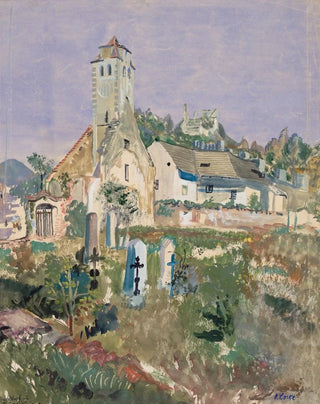Art print | Dürnstein Cemetery - Oskar Laske


View from behind

Frame (optional)
Cimetière de Dürnstein - Oskar Laske – Captivating Introduction
In the artistic landscape of the early 20th century, the artwork "Cimetière de Dürnstein" by Oskar Laske stands out for its ability to capture the essence of a place imbued with history and melancholy. Located in the Danube Valley, the Dürnstein cemetery, with its ancient graves and serene atmosphere, becomes the subject of a visual exploration that transcends a simple motif. Laske's painting evokes not only a geographical space but also a state of mind, a reflection on life and death, on the passage of time and the ephemeral beauty of things. Through this work, the artist invites us on a contemplative walk, immersing us in a world where each stone and shadow tells a story.
Style and uniqueness of the work
Oskar Laske's style is characterized by a subtle approach to landscape, where light and color play a predominant role. In "Cimetière de Dürnstein," the artist uses a delicate palette, oscillating between soft hues and darker shades, to create an atmosphere that is both peaceful and emotionally charged. The forms are treated with precision that demonstrates a deep respect for nature and architecture. The composition, well balanced, guides the viewer's eye across the painting, inviting discovery of every detail, every element of the landscape. The majestic trees, tombstones, and cloudy sky combine to form a scene that evokes serenity and contemplation. Laske's technique, blending Impressionism and realism, allows the texture of the elements to be felt, making the work even more immersive.
The artist and his influence
Oskar Laske, an emblematic figure of Austrian art, managed to establish himself in the art world through his unique approach and sensitivity to the beauty of landscapes. Influenced by the great masters of his time, he developed a style that is his own, combining a deep understanding of natural elements with refined technique. His works, often inspired by nature and historic architecture, reflect a quest for harmony between man and his environment. Las

Matte finish

View from behind

Frame (optional)
Cimetière de Dürnstein - Oskar Laske – Captivating Introduction
In the artistic landscape of the early 20th century, the artwork "Cimetière de Dürnstein" by Oskar Laske stands out for its ability to capture the essence of a place imbued with history and melancholy. Located in the Danube Valley, the Dürnstein cemetery, with its ancient graves and serene atmosphere, becomes the subject of a visual exploration that transcends a simple motif. Laske's painting evokes not only a geographical space but also a state of mind, a reflection on life and death, on the passage of time and the ephemeral beauty of things. Through this work, the artist invites us on a contemplative walk, immersing us in a world where each stone and shadow tells a story.
Style and uniqueness of the work
Oskar Laske's style is characterized by a subtle approach to landscape, where light and color play a predominant role. In "Cimetière de Dürnstein," the artist uses a delicate palette, oscillating between soft hues and darker shades, to create an atmosphere that is both peaceful and emotionally charged. The forms are treated with precision that demonstrates a deep respect for nature and architecture. The composition, well balanced, guides the viewer's eye across the painting, inviting discovery of every detail, every element of the landscape. The majestic trees, tombstones, and cloudy sky combine to form a scene that evokes serenity and contemplation. Laske's technique, blending Impressionism and realism, allows the texture of the elements to be felt, making the work even more immersive.
The artist and his influence
Oskar Laske, an emblematic figure of Austrian art, managed to establish himself in the art world through his unique approach and sensitivity to the beauty of landscapes. Influenced by the great masters of his time, he developed a style that is his own, combining a deep understanding of natural elements with refined technique. His works, often inspired by nature and historic architecture, reflect a quest for harmony between man and his environment. Las






